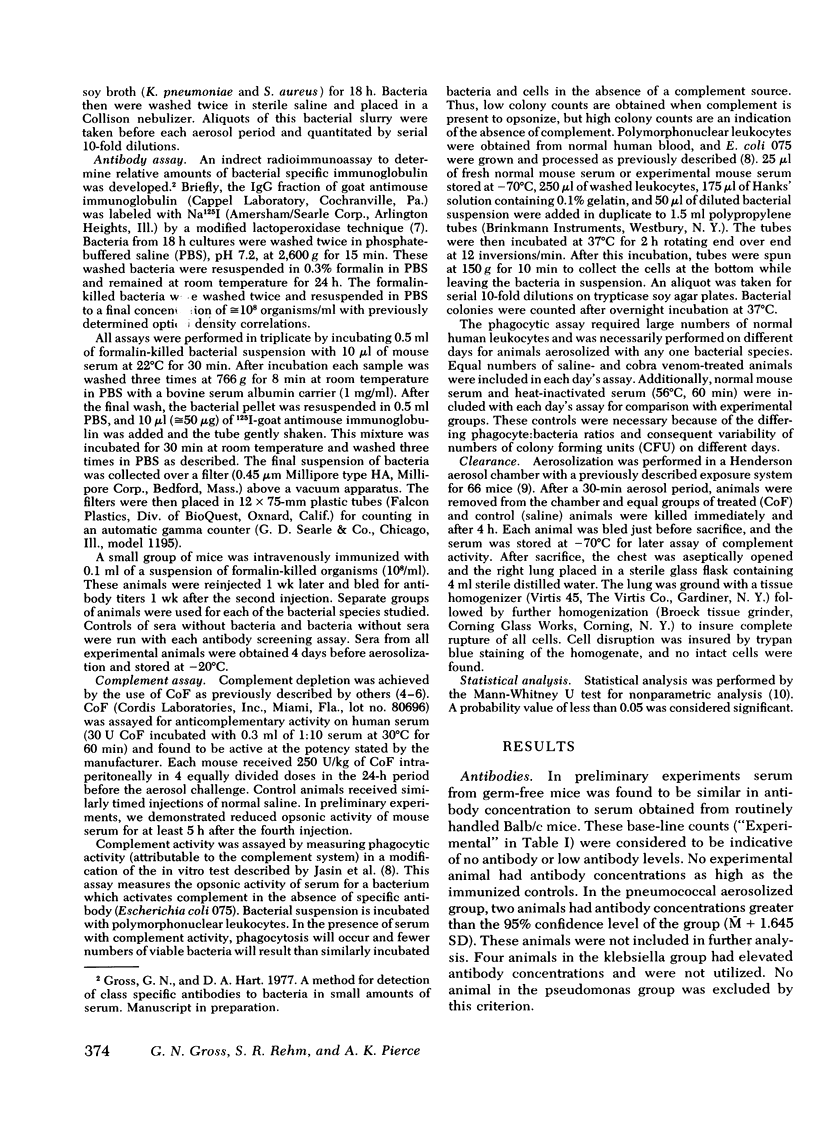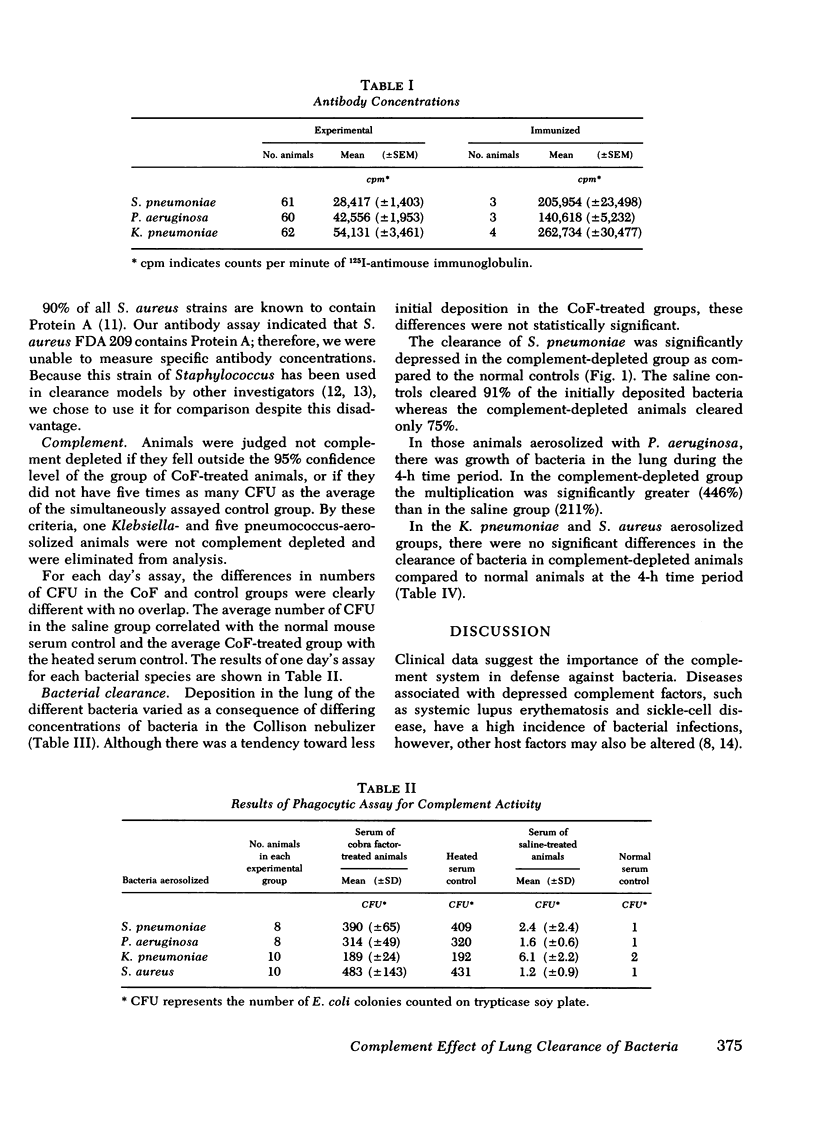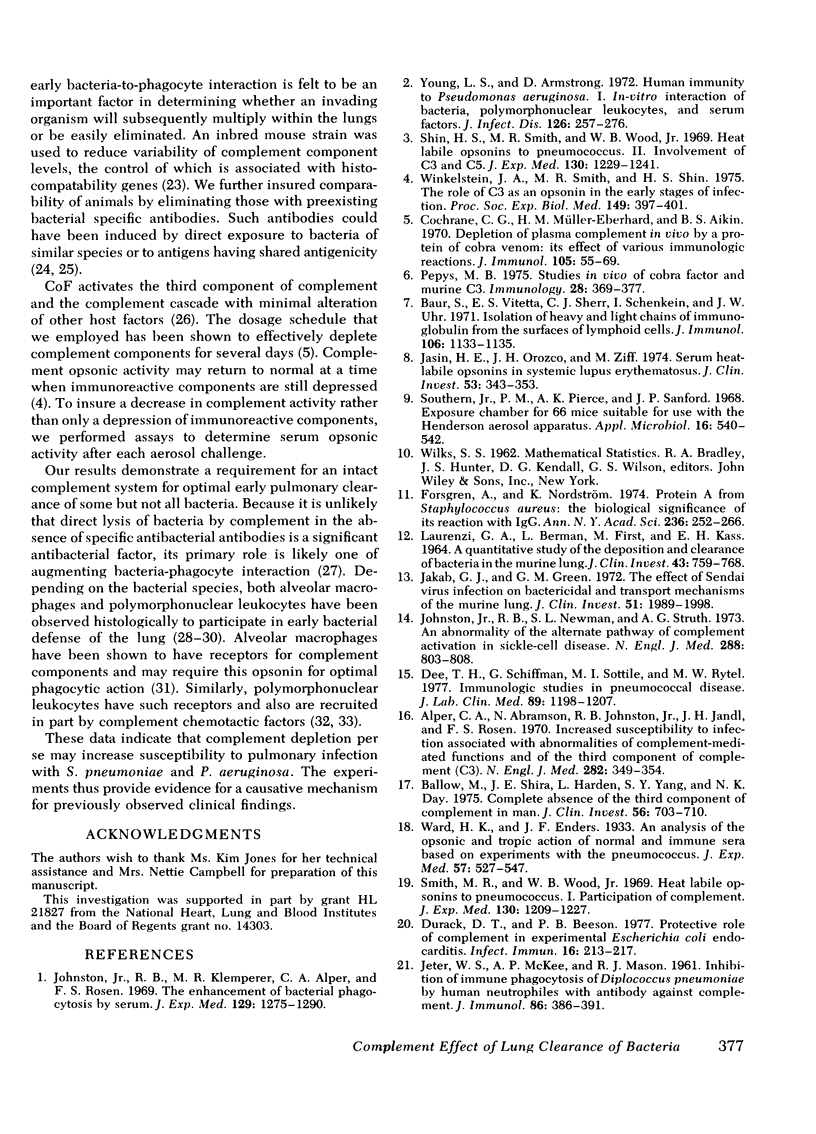Abstract
We have investigated the effect of hypocomplementemia on early pulmonary clearance of four species of bacteria. The experiments were performed in an inbred animal model to minimize immunologic variability. Complement was depleted by cobra venom factor, and activity in serum was monitored with a phagocytic assay. Bacterial specific antibodies were examined by an indirect radioimmunoassay, and animals with high levels of activity were excluded from anaysis. 4 h after aerosolization with Streptococcus pneumoniae, complement-depleted animals had cleared only 75% of the initial number of organisms, whereas saline-treated controls cleared 91% (P less than 0.01). Aerosolization with Pseudomonas aeruginosa was followed at 4 h by a twofold greater growth of organisms in the complement-depleted animals (446% of original deposition) as compared to the saline-treated controls (211% of original deposition) (P less than 0.02). Clearance of Klebsiella pneumoniae and Staphylococcus aureus were similar in complement-depleted animals and saline-treated controls. These experiments suggest that hypocomplementemia predisposes to bacterial pneumonia and may explain the high incidence of pulmonary infections in patients having impaired complement activity. Our results further indicate that varying defense mechanisms may be involved with clearing the lung of differing bacterial species.
Full text
PDF





Selected References
These references are in PubMed. This may not be the complete list of references from this article.
- Alper C. A., Abramson N., Johnston R. B., Jr, Jandl J. H., Rosen F. S. Increased susceptibility to infection associated with abnormalities of complement-mediated functions and of the third component of complement (C3). N Engl J Med. 1970 Feb 12;282(7):350–354. doi: 10.1056/nejm197002122820701. [DOI] [PubMed] [Google Scholar]
- Ballow M., Shira J. E., Harden L., Yang S. Y., Day N. K. Complete absence of the third component of complement in man. J Clin Invest. 1975 Sep;56(3):703–710. doi: 10.1172/JCI108141. [DOI] [PMC free article] [PubMed] [Google Scholar]
- Baur S., Vitetta E. S., Sherr C. J., Schenkein I., Uhr J. W. Isolation of heavy and light chains of immunoglobulin from the surfaces of lymphoid cells. J Immunol. 1971 Apr;106(4):1133–1135. [PubMed] [Google Scholar]
- Cochrane C. G., Müller-Eberhard H. J., Aikin B. S. Depletion of plasma complement in vivo by a protein of cobra venom: its effect on various immunologic reactions. J Immunol. 1970 Jul;105(1):55–69. [PubMed] [Google Scholar]
- Dee T. H., Schiffman G., Sottile M. I., Rytel M. W. Immunologic studies in pneumococcal disease. J Lab Clin Med. 1977 Jun;89(6):1198–1207. [PubMed] [Google Scholar]
- Durack D. T., Beeson P. B. Protective role of complement in experimental Escherichia coli endocarditis. Infect Immun. 1977 Apr;16(1):213–217. doi: 10.1128/iai.16.1.213-217.1977. [DOI] [PMC free article] [PubMed] [Google Scholar]
- Forsgren A., Nordström K. Protein A from Staphylococcus aureus: the biological significance of its reaction with IgG. Ann N Y Acad Sci. 1974 Jul 31;236(0):252–266. doi: 10.1111/j.1749-6632.1974.tb41496.x. [DOI] [PubMed] [Google Scholar]
- Goldman M. B., Goldman J. N. Relationship of functional levels of early components of complement to the H-2 complex of mice. J Immunol. 1976 Nov;117(5 Pt 1):1584–1588. [PubMed] [Google Scholar]
- Goldstein E., Lippert W., Warshauer D. Pulmonary alveolar macrophage. Defender against bacterial infection of the lung. J Clin Invest. 1974 Sep;54(3):519–528. doi: 10.1172/JCI107788. [DOI] [PMC free article] [PubMed] [Google Scholar]
- Henson P. M., Cochrane C. G. The effect of complement depletion on experimental tissue injury. Ann N Y Acad Sci. 1975 Jun 13;256:426–440. doi: 10.1111/j.1749-6632.1975.tb36069.x. [DOI] [PubMed] [Google Scholar]
- JETER W. S., McKEE A. P., MASON R. J. Inhibition of immune phagocytosis of Diplococcus pneumoniae by human neutrophiles with antibody against complement. J Immunol. 1961 Apr;86:386–391. [PubMed] [Google Scholar]
- Jakab G. J., Green G. M. The effect of Sendai virus infection on bactericidal and transport mechanisms of the murine lung. J Clin Invest. 1972 Aug;51(8):1989–1998. doi: 10.1172/JCI107005. [DOI] [PMC free article] [PubMed] [Google Scholar]
- Jasin H. E., Orozco J. H., Ziff M. Serum heat-labile opsonins in systemic lupus erythematosus. J Clin Invest. 1974 Feb;53(2):343–353. doi: 10.1172/JCI107566. [DOI] [PMC free article] [PubMed] [Google Scholar]
- Jay S. J., Johanson W. G., Jr, Pierce A. K., Reisch J. S. Determinants of lung bacterial clearance in normal mice. J Clin Invest. 1976 Apr;57(4):811–817. doi: 10.1172/JCI108356. [DOI] [PMC free article] [PubMed] [Google Scholar]
- Johnston R. B., Jr, Klemperer M. R., Alper C. A., Rosen F. S. The enhancement of bacterial phagocytosis by serum. The role of complement components and two cofactors. J Exp Med. 1969 Jun 1;129(6):1275–1290. doi: 10.1084/jem.129.6.1275. [DOI] [PMC free article] [PubMed] [Google Scholar]
- Johnston R. B., Jr, Newman S. L., Struth A. G. An abnormality of the alternate pathway of complement activation in sickle-cell disease. N Engl J Med. 1973 Apr 19;288(16):803–808. doi: 10.1056/NEJM197304192881601. [DOI] [PubMed] [Google Scholar]
- LAURENZI G. A., BERMAN L., FIRST M., KASS E. H. A QUANTITATIVE STUDY OF THE DEPOSITION AND CLEARANCE OF BACTERIA IN THE MURINE LUNG. J Clin Invest. 1964 Apr;43:759–768. doi: 10.1172/JCI104960. [DOI] [PMC free article] [PubMed] [Google Scholar]
- LOOSLI C. G., BAKER R. F. ACUTE EXPERIMENTAL PNEUMOCOCCAL (TYPE I) PNEUMONIA IN THE MOUSE: THE MIGRATION OF LEUCOCYTES FROM THE PULMONARY CAPILLARIES INTO THE ALVEOLAR SPACES AS REVEALED BY THE ELECTRON MICROSCOPE. Trans Am Clin Climatol Assoc. 1962;74:15–28. [PMC free article] [PubMed] [Google Scholar]
- Lay W. H., Nussenzweig V. Receptors for complement of leukocytes. J Exp Med. 1968 Nov 1;128(5):991–1009. doi: 10.1084/jem.128.5.991. [DOI] [PMC free article] [PubMed] [Google Scholar]
- Pepys M. B. Studies in vivo of cobra factor and murine C3. Immunology. 1975 Feb;28(2):369–377. [PMC free article] [PubMed] [Google Scholar]
- Pierce A. K., Reynolds R. C., Harris G. D. Leukocytic response to inhaled bacteria. Am Rev Respir Dis. 1977 Oct;116(4):679–684. doi: 10.1164/arrd.1977.116.4.679. [DOI] [PubMed] [Google Scholar]
- Reynolds H. Y., Atkinson J. P., Newball H. H., Frank M. M. Receptors for immunoglobulin and complement on human alveolar macrophages. J Immunol. 1975 Jun;114(6):1813–1819. [PubMed] [Google Scholar]
- Schneerson R., Robbins J. B. Induction of serum Haemophilus influenzae type B capsular antibodies in adult volunteers fed cross-reacting Escherichia coli 075:K100:H5. N Engl J Med. 1975 May 22;292(21):1093–1096. doi: 10.1056/NEJM197505222922103. [DOI] [PubMed] [Google Scholar]
- Shin H. S., Smith M. R., Wood W. B., Jr Heat labile opsonins to pneumococcus. II. Involvement of C3 and C5. J Exp Med. 1969 Dec 1;130(6):1229–1241. doi: 10.1084/jem.130.6.1229. [DOI] [PMC free article] [PubMed] [Google Scholar]
- Smith M. R., Wood W. B., Jr Heat labile opsonins to pneumococcus. I. Participation of complement. J Exp Med. 1969 Dec 1;130(6):1209–1227. doi: 10.1084/jem.130.6.1209. [DOI] [PMC free article] [PubMed] [Google Scholar]
- Sorkin E., Stecher V. J., Borel J. F. Chemotaxis of leucocytes and inflammation. Ser Haematol. 1970;3(1):131–162. [PubMed] [Google Scholar]
- Southern P. M., Jr, Pierce A. K., Sanford J. P. Exposure chamber for 66 mice suitable for use with the henderson aerosol apparatus. Appl Microbiol. 1968 Mar;16(3):540–542. doi: 10.1128/am.16.3.540-542.1968. [DOI] [PMC free article] [PubMed] [Google Scholar]
- Springer G. F., Horton R. E. Blood group isoantibody stimulation in man by feeding blood group-active bacteria. J Clin Invest. 1969 Jul;48(7):1280–1291. doi: 10.1172/JCI106094. [DOI] [PMC free article] [PubMed] [Google Scholar]
- Winkelstein J. A., Smith M. R., Shin H. S. The role of C3 as an opsonin in the early stages of infection. Proc Soc Exp Biol Med. 1975 Jun;149(2):397–401. doi: 10.3181/00379727-149-38815. [DOI] [PubMed] [Google Scholar]
- Young L. S., Armstrong D. Human immunity to Pseudomonas aeruginosa. I. In-vitro interaction of bacteria, polymorphonuclear leukocytes, and serum factors. J Infect Dis. 1972 Sep;126(3):257–276. doi: 10.1093/infdis/126.3.257. [DOI] [PubMed] [Google Scholar]


